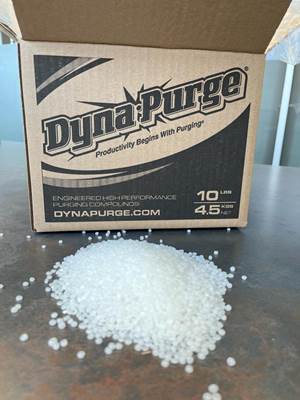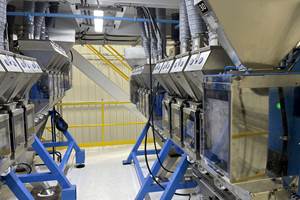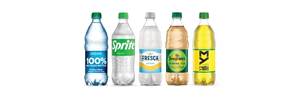From NPE 2000: The Latest Instruments For Testing & QC
The huge triennial plastics exhibition in June showcased new developments in product inspection and lab instruments for testing mechanical properties, melt rheology, weatherability, color, and appearance.If you are looking to outfit a new lab or upgrade an existing one, the NPE 2000 show in Chicago this past June spotlighted many new instruments for use in product development, material evaluation, and quality control.
The huge triennial plastics exhibition in June showcased new developments in product inspection and lab instruments for testing mechanical properties, melt rheology, weatherability, color, and appearance.
If you are looking to outfit a new lab or upgrade an existing one, the NPE 2000 show in Chicago this past June spotlighted many new instruments for use in product development, material evaluation, and quality control. Apart from equipment and software for testing mechanical, rheological, weathering, and color/appearance properties, there was also a variety of new inspection devices for lab or shop-floor use.
For mechanical testing
If you perform a high volume of impact testing, you can get help from the new Resilvis 2000 fully automatic Izod and Charpy tester, which runs up to three samples a minute. This unit from Ceast USA conditions and tests specimens in a temperature range of -158 to +212 F. It has optional automatic identification of ductile vs. brittle breaks and can work with the company’s DAS 4000 instrumented impact system to provide complete force/time curves.
Don’t worry about fatigue from notching all those samples to keep up with the automatic impact tester: Tinius Olsen came out with the Model 899 fully automatic specimen notcher for Izod and Charpy tests. It has a single-tooth diamond cutter to make precise notches according to ASTM and ISO standards. This competitively priced unit features a safety shield and optional vacuum attachment to remove shavings.
For extra certainty that your test data are consistent with industry standards, Tinius Olsen also offers the new Model 799 notch-depth verification device, available with digital or analog dials.
Another new system performs automatic tensile, compression, or flexural testing of up to five specimens at a time. MTS Systems’ MultiHead universal tester automatically computes and archives test results using the company’s TestWorks 4 software. The graphical user interface reportedly makes simple work of configuring test procedures.
Shimadzu Scientific Instruments unveiled at the show the Autograph AG-I Series of universal testing instruments. They come in seven load ranges from 200 to 50,000 lbf and test speeds from 0.00002 to 40 in./min. Trapezium software for Windows 95/98 and NT 4.0 is said to perform ultra-fast data sampling at 1.25-millisec intervals and provide test-force precision of ±0.5%.
Get precise and repeatable data—even on elastomeric materials that were previously difficult or impossible to test accurately—with the new TMI Stress-Strain Micrometer from Testing Machines, Inc. It tests for peak load, static load, thickness, and stress-strain behavior. The instrument’s ability to accurately control a user-specified rate of loading is said to be a unique feature. Speed range is 0.01 to 762 mm/min, and reported speed accuracy is 0.05% of setpoint (steady state).
A new digital force meter for tensile and compression testing is priced 20% to 30% lower than competitive models, according to Com-Ten Industries. Its DFM-5000 comes with capacities of 10 to 5000 lb and hand-operated, fixed, or variable-speed motorized test stands. A two-line LCD displays continuous and peak force in a variety of units. Calibration is traceable to NIST and accurate to 0.1% of full scale. The DFM-5000 can be used with Com-Ten’s new 95 Series variable-speed test stand for tensile and compression testing.
New Benzwin 2000 software from Benz Testing Machines operates with most testing instruments supplied by this company as well as many instruments from other firms. Based on Windows 98 and NT, it acquires test data (five to 100 samples/sec), presents it in real-time graphical format, and produces reports in graphical and tabular formats. It can automatically adjust and run several tests simultaneously and can run tests for days without operator-defined file sizes.
New melt rheometers
Ceast’s new MFT 130 melt indexer is designed to overcome the difficulties of accurately measuring “fractional melts” lower than 0.5 g/10 min, where operator technique is especially critical. With this instrument, operators can program a constant compacting force of up to 130 kg, followed by automatic preheating and testing. All test phases are automated except sample loading and cleaning. A digital encoder measures piston travel with up to 40 data points per test. The operator can select test start point, maximum test period, and size of measurement field (as little as 2.5 mm of piston travel).
Another advanced melt indexer, Tinius Olsen’s new Model MP600, is a basic unit that can be upgraded with modular accessory packages for more automated testing. The modules can add automatic timing, control of multiple units from a single PC, and automatic measurements using up to three different loads in one test. However, even the base model has a menu-driven controller/timer that guides the user throughout the test and calculates and displays test results.
If you need to test filled thermoplastics and composites over a range of shear rates, Rosand Precision offers its new RH2000 Series capillary rheometer with high-pressure capability. Single- and twin-bore models have a digital servomotor drive with 40-kN (4.4-ton) force capacity. New-generation software for Windows 98 or NT offers nearly full automation from starting a test to data analysis.
LCR 7002, a new dual-bore capillary rheometer from Dynisco Polymer Test, allows simultaneous testing at low and high shear rates. By placing a short L/D in one bore and a long L/D in the other bore, Bagley corrections and elongation data can be acquired in one test run.
Dynisco also showed its new ViscoSensor, a return stream on-line rheometer that continually measures the viscosity and/or melt index of molten polymer and then returns it to the process by means of a special double-walled pipe. The unit is said to be compact, low-cost, and easy to install and maintain.
The new Intelli-Torque Plasti-Corder torque rheometer from C.W. Brabender has a digital servodrive system that reportedly provides precise and constant speed control even under the harshest test conditions. Test parameters are set through Windows software programs.
Can you get stable on-line viscosity measurements of abrasive, highly filled materials? Yes, you can, says Chemical Electrophysics Co. of its new Rheoceptor line of squeezing-flow process viscometers. They employ a cam that rotates in a cylindrical cavity and squeezes melt against the wall. The cam can be built into an extruder as a short section of the screw or built into a gear pump and turned by the pump shaft. A fast-response pressure transducer mounted flush with the wall detects a pressure pulse each time the cam passes. The amplitude of the pulse is proportional to the viscosity of the material. The shear rate is determined from the time interval between pulses. Two-lobed cams take five measurements at two shear rates.
The unit is also offered as a side-stream gear-pump viscometer that provides variable shear rate and is said to be easy to install. Prices range between $25,000 and $35,000.
Check color & appearance
Two new grating-type spectrophotometers were launched by Color Instruments Inc. The ColorMite is a compact sensor that turns an ordinary PC into a very sensitive spectrophotometer for on-line monitoring or laboratory use. Its miniature size (as small as modem card) is said to offer high performance at nearly half the cost of other sensors. It can be customized with 45/0°, sphere or other geometries; integral or remote heads; wavelength ranges of 350-850, 200-600, or 500-1000 nm; and measurement area from 0.4 to 10 mm. Software options offer measurements in transmittance, reflectance, absorbance, and irradiance modes.
The company’s new Colorport unit is a portable, dual-beam 45/0° spectrophotometer that performs true 10-nm color measurement and is priced about 50% below competitive models. This 3.1-lb unit takes both reflectance and transmittance measurements. Its built-in QC functions include storage and recall of standards and 1000 samples, selectable averaging of measurements, and pass/fail tolerances.
Another dual-beam spectrophotometer is HunterLab’s new ColorQuest XE, with diffuse/8° geometry. It measures reflectance and transmittance plus haze, opacity, color strength, APHA (Hazen), gloss (specular component included or excluded), and yellowness/whiteness indexes. The company’s universal QC software collects, displays, analyzes, and stores data.
The Model CM-3600d benchtop spectrophotometer is the first of Minolta’s new Enhanced Performance Technology series. This dual-beam, sphere-type reference instrument measures reflectance and transmittance. It incorporates two patented advances: automatic numerical uv adjustment for measuring fluorescent samples, and simultaneous measurement of the specular component included and excluded for glossy/non-glossy comparisons.
Minolta also showcased a new version of its popular CR-300 QC colorimeter. Model CT-310 has a special sample holder for measuring PET bottle preforms.
New from Tricor Systems are 820 Series video photometers that measure the absolute brightness of any size sample in fl or cd/m2. These units are used to measure paint reflectance or brightness of LEDs, backlit panels, and control switches.
‘Color-management’ help
Color-measurement hardware entries at NPE were supplemented by new software systems that use the Internet to assist color users and compounders. For instance, Datacolor International unveiled the Color Information Management System (CIMS), which allows users to create, specify, and communicate colors precisely to customers or suppliers anywhere in the world.
CIMS includes new Colorite technology for color communications over the Internet. It is said to cut sampling costs in half by allowing everyone involved in the color decision process to see and communicate color digitally and in real time.
GretagMacbeth showcased the NetProfiler, its new Web-enabled instrument-management software. It allows users to automatically test and calibrate instruments via Internet link to GretagMacbeth’s standards lab. This provides constant assurance that quantification of colors is uniform among all of a user’s instruments, regardless of location. GE Plastics is using this system for color communication among its facilities and for monthly color certification. (Information and demonstrations are available on-line at www.NetProfiler.org.)
GretagMacbeth also showed new Version 4.0 of ProPalette Plastics, a complete color-formulation and QC software package. This reportedly easy-to-use colorant calibration program requires only three to seven samples to build a database. It accommodates transparent, translucent, and opaque matching and is compatible with any GretagMacbeth spectrophotometer, and other competing instruments, the company says.
Formulation-Master 2001, a streamlined color-formulation software package, was introduced by X-Rite. This “networkable” system allows multiple users to access a single set of calibration data and standards.
For other types of tests
Dynisco Polymer Test is now manufacturing and selling hot-tack and heat-seal test equipment under an agreement with Theller Engineering Corp. of Petaluma, Calif.
And for weatherability testing, Q-Panel Lab Products brought out two new Q-Sun economically priced xenon-arc instruments to test color change, fading, and loss of physical properties in outdoor products. New Model 1000 is a compact table-top unit. The larger new Q-Sun/3000 is a full-featured, free-standing model.
New for parts inspection
If you need a close-up view of part features or defects, Optical Gaging Products has brought out a new generation of SmartScope vision inspection systems. They have a powerful new 12x zoom lens, an “elevating bridge” to provide both Z-axis and X-axis motion, and the patented SmartRing, an array of LED lights beneath the sample that tracks the optical system as it moves.
These units run with OGP’s new MeasureX Metrology software for Windows 95/98 and NT. It features a full set of image-processing tools, geometric functions, tolerances, and real-time SPC reporting software.
Vision Engineering introduced Lynx, a stereo zoom inspection microscope that offers up to 120x magnification, a large viewing area, and long working distances for applications where sample manipulation is necessary.
Detect and reject decoration defects on plastic caps and closures with the new Extractor TVX from Pressco Technology. It uses machine vision and image analysis detect ink splatters and smears, misaligned decoration, and incomplete labels. The camera, lighting, and electronics are all housed in a compact enclosure.
The newest version of a hand-held magnetic (Hall effect) thickness sensor is the Magna-Mike model 8500 from Panametrics. It is designed to provide quick digital readings in tight corners and grooves down to a radius of 1/32 in. Measurements are made by holding a magnetic probe on one side of the part and a small steel target ball on the opposite side.
AGR International launched its own Hand Held Thickness Probe 2000 (HHTP2000), a portable thickness-measuring device for use on the plant floor. It uses AGR’s patented capacitance technology to “touch and measure” products up to 0.20 in. thick without the need for target balls or coupling fluids. It is recommended for bottles, containers, or other hollow products where only single-sided measurement is possible.
Related Content
'Dual Action' Purging Compound Accelerates Color Changes
NPE2024: Shuman Plastics’ Dyna-Purge Division launches Dyna-Purge L, extending its “3X technology.”
Read MoreNovel System Produces Color on Demand
Ampacet’s FluxQF technology features a quick-dispersion universal carrier with novel machinery that provides automated color blending in quantities down to 50 lb.
Read MoreUnderstanding the ‘Science’ of Color
And as with all sciences, there are fundamentals that must be considered to do color right. Here’s a helpful start.
Read MoreCoke Makes Bottle Changes to Boost Recycling
Sprite bottles will be clear, while Dasani bottles will be made with recycled plastic.
Read MoreRead Next
People 4.0 – How to Get Buy-In from Your Staff for Industry 4.0 Systems
Implementing a production monitoring system as the foundation of a ‘smart factory’ is about integrating people with new technology as much as it is about integrating machines and computers. Here are tips from a company that has gone through the process.
Read MoreBeyond Prototypes: 8 Ways the Plastics Industry Is Using 3D Printing
Plastics processors are finding applications for 3D printing around the plant and across the supply chain. Here are 8 examples to look for at NPE2024.
Read More








 (2).jpg;maxWidth=300;quality=90)


















